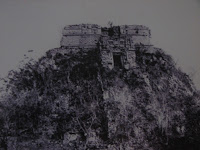Update: a friend said stop yakking and add some pictures. So I did. A combo of my own photographs and Google Street View snapshots.
Despite my excellent repair, the hammock here was making some disquieting sounds whenever I got in -- strings popping and little ripppping noises -- I think it is on its last legs with advanced dry rot.
So I thought about getting a new one. Did some research, discovered a lot about the local hammock industry. There are a couple of high end hammock boutiques, and at the other end a lot street vendors selling plastic hammocks.
Then I found out on line about a place called Hamacas El Aguacate (The Avocado Hammocks). Well reviewed:
"This is where the locals buy them - good fair prices to start, all hand made and a reputable seller." Thought that sounded good, so I decided to visit. A very interesting walk of a mile or so to get there.
 |
| El Aguacate (Google Street View) |
El Aguacate isn't in the tourist district. In fact, it isn't even in the low-rent commercial district. It is south of the second class bus station, in what turned out to be the red-light district. Even at two in the afternoon ladies were blowing kisses and winking as I passed, and I'm confident it wasn't because of my boyish good looks. Got a snapshot later of the hotel across the street from El Aguacate, courtesy of Google. Cat sitting in the door is a nice touch.
 |
| Across the street (Google Street View) |
When I got to El Aguacate, had a conversation mainly in Spanish with the owner and an employee. Poor Spanish to be sure, but Spanish all the same, and I was happy with that. They showed me some hammocks.
You can get wonderful hammocks, hand woven under conditions that would make anyone proud to participate -- hammocks that help
"alleviate poverty, promote gender equality and inspire social entrepreneurship." (quote from one of the hammock boutiques).
They are beautiful hammocks and great goals, and it is nice to help achieve outcomes like those by stretching out in a hammock. But they are also kind of expensive hammocks. And I looked at one of them today at El Aguacate. Frankly, it was too fine a piece of artisanship for me to ever feel completely comfortable just hanging around in it. I would worry about spilling something on it, or at minimum feel I should wash up and shave before getting into it. So I asked whether they had something a bit plainer.
 |
| Bonus sogas para hamaca |
They showed me a cotton hammock that was exactly what I hoped for: just like the one here, but without the dry rot! I asked the price, and was pleasantly surprised when I figured out it was $27 -- that is a very relaxing kind of price. Of course I knew immediately I was going to buy it, but didn't feel I'd be keeping up my end of the conversation if I just said
"sold!" So I asked if that included some extra rope to help hang it, and they replied basically
"why not?" Then cash changed hands.
 |
| Hamaca in operation |
This hammock has no pedigree. It may unravel beneath me as I sleep. But it sure is comfortable.
 Since discovering the lady who makes fresh juices, I've stayed pretty much with juice of oranges + x + y ... the reddish end of the color spectrum generally.
Since discovering the lady who makes fresh juices, I've stayed pretty much with juice of oranges + x + y ... the reddish end of the color spectrum generally.




















































